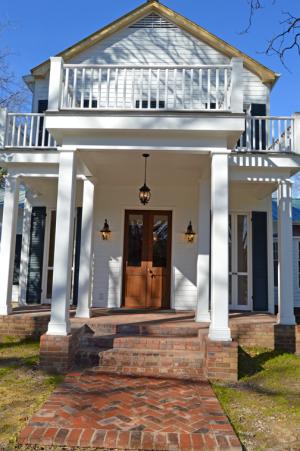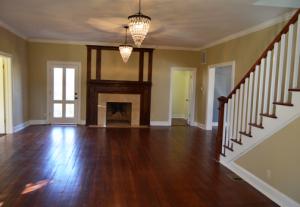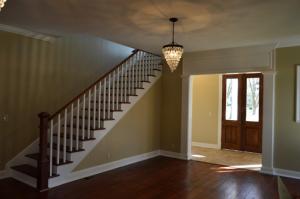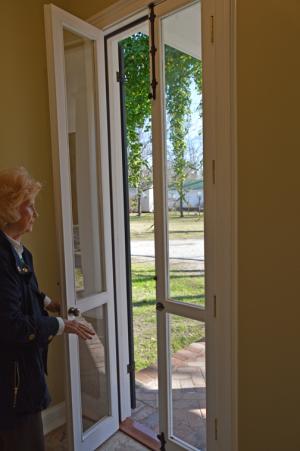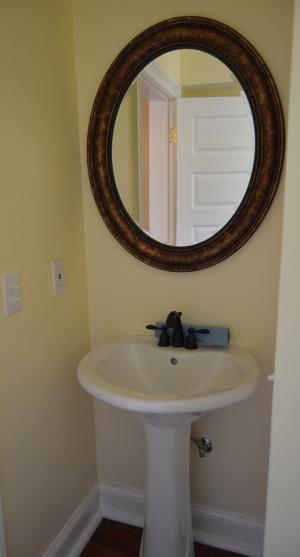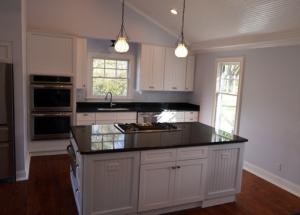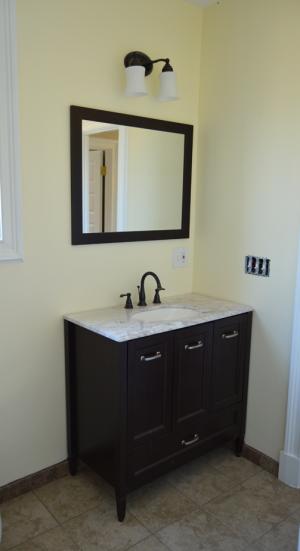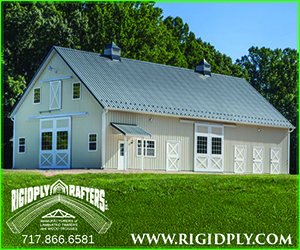Something old…
An 1837 historic home
Lots that’s new…
Completely remodeled home, especially kitchen with all new appliances, and bathrooms
Something borrowed…
The sets of French windows on either side of the front entrance, and a matching pair upstairs
Something blue…
The spacious dining area and a downstairs bedroom
Mimosa is the name of several antebellum plantation homes across the south. There’s one in Texas, one in Alabama, one in Georgia, and another in North Carolina. So it should come as no surprise that one named Mimosa exists in historic La Grange, Tennessee. It was originally built in 1837, but has recently been restored to a new lease on life by Collierville resident and Banyan Tree realtor Mary Jean Smith – actually by her husband Bob and a good carpenter friend, Johnny Folsom. This was their second restoration project in La Grange; the first was Tiara, built in 1845, that sits just across the street from Mimosa.
The origins of Mimosa are difficult to ascertain. Mary Jean Smith writes, “The Original Town Plan of La Grange shows the house site as Lot 11, which was owned by Mrs. E. G. Grove. That was in 1861. There was a Baptist Church in LaGrange at that time, on lot 173 where Pankey’s Store is now, but it was blown away by the 1901 tornado.” Rumors are that Mimosa could have been the Baptist preacher’s home, but historic details are sketchy.
At the La Grange Tennessee website, the Town Directory lists Pine Hill Baptist Church as organized in 1839. But the Pine Hill Baptist Church page says that it was founded in 1910 by William Elrod, who was born in 1850. Elrod was a minister and farmer in La Grange, who served as Baptist minister from 1871 until his death in 1920. The website says Pine Hill Baptist Church is located at Main Street (Yager Drive). Pankey’s Store is located at 20 Main Street.
Mary Jean continues, “At some later date, probably in the 1930s or 1940s and 1950s, the house was owned by Mr. Lee Hoffman and his wife Dorothy. Mr. Hoffman was a well known bird dog trainer in the area, which no doubt, explains why the old stable has dog kennels built in it. They eventually moved to the Ames Plantation” area.
According to Rick Carlisle, Director of Ames Plantation, Hoffman was a buddy of Wilson Dunn and Hoffman did live on property adjacent to Ames Plantation. He bought 20 acres from Wilson Dunn and Hoffman’s house and land were, at the time, completely surrounded by Ames Plantation, but were not a part of Ames. His land was located on what is now National Championship Drive, but was called Lee Hoffman Drive at the time he lived there. As folks passed away, Ames Plantation eventually bought the Hoffman land and remaining land owned by Wilson Dunn. Now these lands are part of the grounds across which the morning brace of the National Championship is run.
Hoffman was very active in bird dog field trials at Ames. In May 1952 a group of local field trial enthusiasts created the Hobart Ames Memorial Field Trial Club (HAMFTC). Lee Hoffman was associated with the Club from its inception as a member, a participant in the field trials, and later as the driver of the dog wagon. Hoffman was one of many knowledgeable men who gave their time and efforts to ensure the success of the HAMFTC. Hoffman was also a winning handler, capturing first place in the Hobart Ames Memorial Field Trial Open stakes held January 3, 1955 with E Bee’s Expressman. In 1957 Midnight Lou was awarded second place in the Hobart Ames Memorial Derby stake for handler Lee Hoffman and owner Dr. F.S. McKnight. Hoffman’s photo currently hangs in the Bird Dog Museum in Grand Junction, TN. [information from the Ames Plantation, “Sixty Year Summary of the Hobart Ames Memorial Field Trial”]
There is a post about the National Championship on the Memphis Commercial Appeal Topix forum dated April 21, 2012 from Jim Hoffman, Conroe, Texas. “I read where Robin Gates was the handler. Wow, does that bring back old memories. In 1955, John Gates stayed at our home in La Grange, Tn. and Mr. Gates’ scout used my horse, “Littleman.” He was a good friend of ours. My dad’s name was Lee Hoffman…” [source: http://www.topix.com/forum/city/grand-junction-tn/TMCGAIGARHF559A25]
The next owners of Mimosa were Downing family, of which Mrs. Vera Downing, the LaGrange Town Clerk, is a member. There was one other interim owner, from whom Mary Jean Smith bought the house.
Looking at the condition of the house before Smith and her husband started the project, it was clear they had a lot of work ahead of them. Mary Jean says her husband has a great deal of architectural and engineering talent. “And we have a wonderful carpenter who works for us [Johnny Folsom],” Mary Jean said. “He and my husband did it together.” The team worked for a year and a half bringing the house to its present glory.
The first thing they had to do was change the front entrance to face Fourth Street. The house originally faced LaGrange Road, but there is a very steep bank between the yard and LaGrange Road which is nearly impassable by car. There was an existing entrance from Fourth Street, but that was to the kitchen. So now the main entrance to the house faces Fourth Street, just across from Tiara.
The original heart pine floors were removed, refurbished, and then replaced. The new heart pine floor in the dining room was selected to match the historic floors in the house – and one cannot see the difference upon close inspection.
The house’s three upstairs bedrooms are the oldest part of the house. There are two fireplaces, one upstairs and one downstairs. The kitchen has all new, stainless steel appliances. The roof is new; the siding is new; the gutters are new; and the plumbing and wiring have all been redone.
An interesting feature of the house is a set of French windows on either side of the front entrance, and another set upstairs. They were not original to the house, but Mary Jean thought they would make a nice additional feature since they are traditionally found in other southern antebellum houses. They can be opened for air flow throughout the house. So many of the original windows were deteriorated that most had to be replaced. “These days everyone wants double-pane windows for efficiency anyway,” Mary Jean said.
As they were doing the restoration, Mary Jean had many meetings with the historical commission to make sure their work was in keeping with the historic district requirements. So the house has kept its most important historical elements while incorporating the modern conveniences that people want and need.
If the house could speak, it might have many interesting tales of bird dogs and field trials and former occupants to tell. The barn still awaits its renovation from the next occupants. If you’re in the market for an historic home in a quaint, historic community, Mimosa is for sale at $299,000. See Mary Jean Smith at Banyan Tree Realtors, (901) 359-2520.
An 1837 historic home
Lots that’s new…
Completely remodeled home, especially kitchen with all new appliances, and bathrooms
Something borrowed…
The sets of French windows on either side of the front entrance, and a matching pair upstairs
Something blue…
The spacious dining area and a downstairs bedroom
Mimosa is the name of several antebellum plantation homes across the south. There’s one in Texas, one in Alabama, one in Georgia, and another in North Carolina. So it should come as no surprise that one named Mimosa exists in historic La Grange, Tennessee. It was originally built in 1837, but has recently been restored to a new lease on life by Collierville resident and Banyan Tree realtor Mary Jean Smith – actually by her husband Bob and a good carpenter friend, Johnny Folsom. This was their second restoration project in La Grange; the first was Tiara, built in 1845, that sits just across the street from Mimosa.
The origins of Mimosa are difficult to ascertain. Mary Jean Smith writes, “The Original Town Plan of La Grange shows the house site as Lot 11, which was owned by Mrs. E. G. Grove. That was in 1861. There was a Baptist Church in LaGrange at that time, on lot 173 where Pankey’s Store is now, but it was blown away by the 1901 tornado.” Rumors are that Mimosa could have been the Baptist preacher’s home, but historic details are sketchy.
At the La Grange Tennessee website, the Town Directory lists Pine Hill Baptist Church as organized in 1839. But the Pine Hill Baptist Church page says that it was founded in 1910 by William Elrod, who was born in 1850. Elrod was a minister and farmer in La Grange, who served as Baptist minister from 1871 until his death in 1920. The website says Pine Hill Baptist Church is located at Main Street (Yager Drive). Pankey’s Store is located at 20 Main Street.
Mary Jean continues, “At some later date, probably in the 1930s or 1940s and 1950s, the house was owned by Mr. Lee Hoffman and his wife Dorothy. Mr. Hoffman was a well known bird dog trainer in the area, which no doubt, explains why the old stable has dog kennels built in it. They eventually moved to the Ames Plantation” area.
According to Rick Carlisle, Director of Ames Plantation, Hoffman was a buddy of Wilson Dunn and Hoffman did live on property adjacent to Ames Plantation. He bought 20 acres from Wilson Dunn and Hoffman’s house and land were, at the time, completely surrounded by Ames Plantation, but were not a part of Ames. His land was located on what is now National Championship Drive, but was called Lee Hoffman Drive at the time he lived there. As folks passed away, Ames Plantation eventually bought the Hoffman land and remaining land owned by Wilson Dunn. Now these lands are part of the grounds across which the morning brace of the National Championship is run.
Hoffman was very active in bird dog field trials at Ames. In May 1952 a group of local field trial enthusiasts created the Hobart Ames Memorial Field Trial Club (HAMFTC). Lee Hoffman was associated with the Club from its inception as a member, a participant in the field trials, and later as the driver of the dog wagon. Hoffman was one of many knowledgeable men who gave their time and efforts to ensure the success of the HAMFTC. Hoffman was also a winning handler, capturing first place in the Hobart Ames Memorial Field Trial Open stakes held January 3, 1955 with E Bee’s Expressman. In 1957 Midnight Lou was awarded second place in the Hobart Ames Memorial Derby stake for handler Lee Hoffman and owner Dr. F.S. McKnight. Hoffman’s photo currently hangs in the Bird Dog Museum in Grand Junction, TN. [information from the Ames Plantation, “Sixty Year Summary of the Hobart Ames Memorial Field Trial”]
There is a post about the National Championship on the Memphis Commercial Appeal Topix forum dated April 21, 2012 from Jim Hoffman, Conroe, Texas. “I read where Robin Gates was the handler. Wow, does that bring back old memories. In 1955, John Gates stayed at our home in La Grange, Tn. and Mr. Gates’ scout used my horse, “Littleman.” He was a good friend of ours. My dad’s name was Lee Hoffman…” [source: http://www.topix.com/forum/city/grand-junction-tn/TMCGAIGARHF559A25]
The next owners of Mimosa were Downing family, of which Mrs. Vera Downing, the LaGrange Town Clerk, is a member. There was one other interim owner, from whom Mary Jean Smith bought the house.
Looking at the condition of the house before Smith and her husband started the project, it was clear they had a lot of work ahead of them. Mary Jean says her husband has a great deal of architectural and engineering talent. “And we have a wonderful carpenter who works for us [Johnny Folsom],” Mary Jean said. “He and my husband did it together.” The team worked for a year and a half bringing the house to its present glory.
The first thing they had to do was change the front entrance to face Fourth Street. The house originally faced LaGrange Road, but there is a very steep bank between the yard and LaGrange Road which is nearly impassable by car. There was an existing entrance from Fourth Street, but that was to the kitchen. So now the main entrance to the house faces Fourth Street, just across from Tiara.
The original heart pine floors were removed, refurbished, and then replaced. The new heart pine floor in the dining room was selected to match the historic floors in the house – and one cannot see the difference upon close inspection.
The house’s three upstairs bedrooms are the oldest part of the house. There are two fireplaces, one upstairs and one downstairs. The kitchen has all new, stainless steel appliances. The roof is new; the siding is new; the gutters are new; and the plumbing and wiring have all been redone.
An interesting feature of the house is a set of French windows on either side of the front entrance, and another set upstairs. They were not original to the house, but Mary Jean thought they would make a nice additional feature since they are traditionally found in other southern antebellum houses. They can be opened for air flow throughout the house. So many of the original windows were deteriorated that most had to be replaced. “These days everyone wants double-pane windows for efficiency anyway,” Mary Jean said.
As they were doing the restoration, Mary Jean had many meetings with the historical commission to make sure their work was in keeping with the historic district requirements. So the house has kept its most important historical elements while incorporating the modern conveniences that people want and need.
If the house could speak, it might have many interesting tales of bird dogs and field trials and former occupants to tell. The barn still awaits its renovation from the next occupants. If you’re in the market for an historic home in a quaint, historic community, Mimosa is for sale at $299,000. See Mary Jean Smith at Banyan Tree Realtors, (901) 359-2520.
